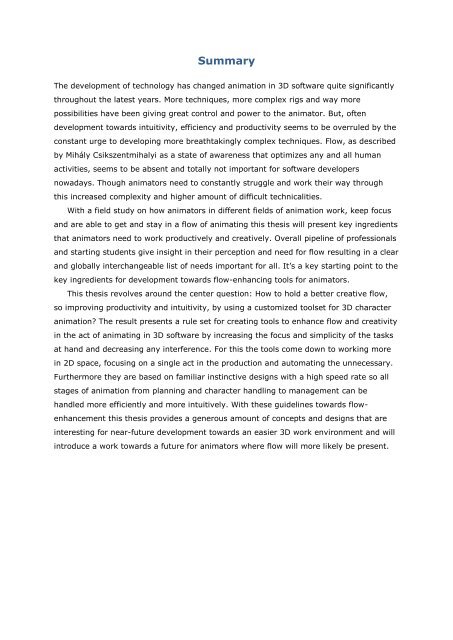Release. Pressure. Animate.
Release. Pressure. Animate.
Release. Pressure. Animate.
Create successful ePaper yourself
Turn your PDF publications into a flip-book with our unique Google optimized e-Paper software.
Summary<br />
The development of technology has changed animation in 3D software quite significantly<br />
throughout the latest years. More techniques, more complex rigs and way more<br />
possibilities have been giving great control and power to the animator. But, often<br />
development towards intuitivity, efficiency and productivity seems to be overruled by the<br />
constant urge to developing more breathtakingly complex techniques. Flow, as described<br />
by Mihály Csikszentmihalyi as a state of awareness that optimizes any and all human<br />
activities, seems to be absent and totally not important for software developers<br />
nowadays. Though animators need to constantly struggle and work their way through<br />
this increased complexity and higher amount of difficult technicalities.<br />
With a field study on how animators in different fields of animation work, keep focus<br />
and are able to get and stay in a flow of animating this thesis will present key ingredients<br />
that animators need to work productively and creatively. Overall pipeline of professionals<br />
and starting students give insight in their perception and need for flow resulting in a clear<br />
and globally interchangeable list of needs important for all. It‟s a key starting point to the<br />
key ingredients for development towards flow-enhancing tools for animators.<br />
This thesis revolves around the center question: How to hold a better creative flow,<br />
so improving productivity and intuitivity, by using a customized toolset for 3D character<br />
animation? The result presents a rule set for creating tools to enhance flow and creativity<br />
in the act of animating in 3D software by increasing the focus and simplicity of the tasks<br />
at hand and decreasing any interference. For this the tools come down to working more<br />
in 2D space, focusing on a single act in the production and automating the unnecessary.<br />
Furthermore they are based on familiar instinctive designs with a high speed rate so all<br />
stages of animation from planning and character handling to management can be<br />
handled more efficiently and more intuitively. With these guidelines towards flow-<br />
enhancement this thesis provides a generous amount of concepts and designs that are<br />
interesting for near-future development towards an easier 3D work environment and will<br />
introduce a work towards a future for animators where flow will more likely be present.


